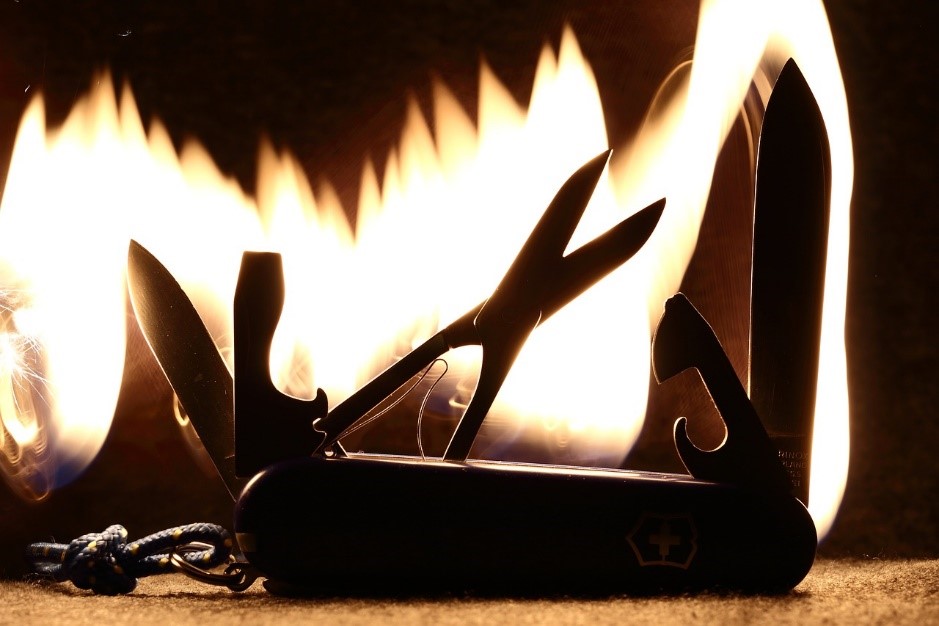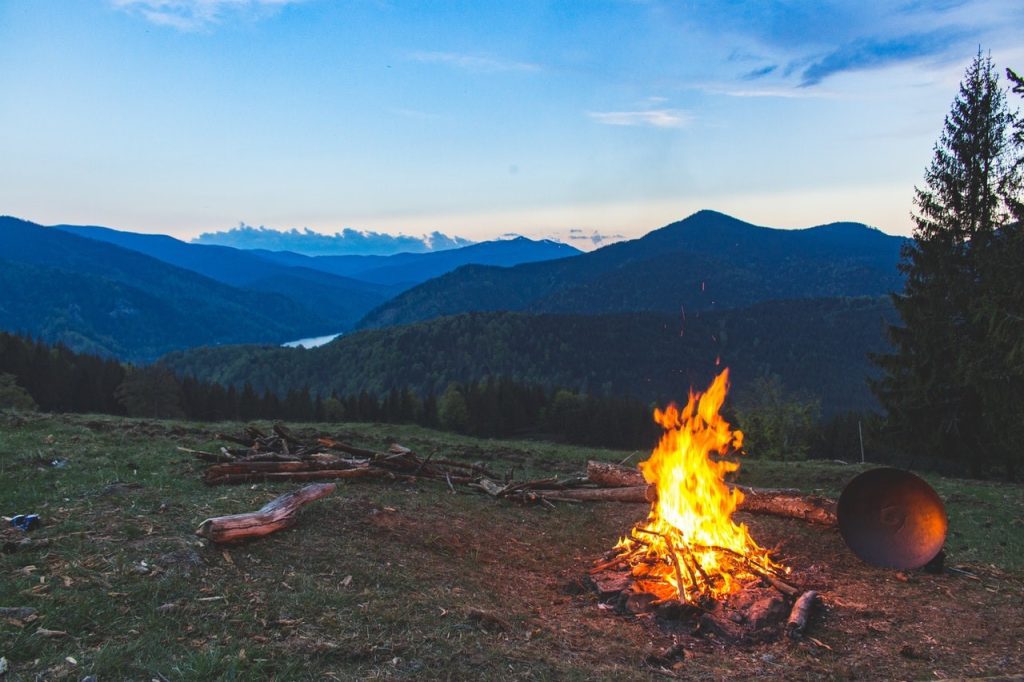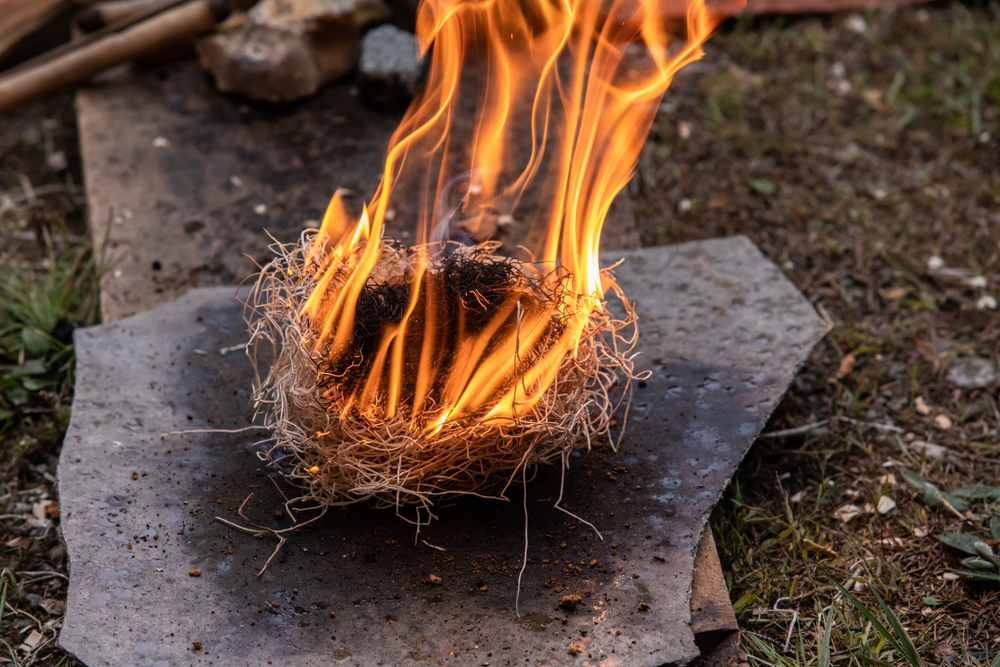Last Updated on October 12, 2022 by admin_hunter
There are many ways to start a fire outdoors. The tools range from matches, lighters, friction from rubbing two sticks together, magnifying lenses, battery and steel wool, fire pistons, and flint and steel.
All these have their merits and shortcomings, and it is advisable to have a combination in your survival pack to cover your bases.
Today we shall focus on one of these tools in a quest to give a comprehensive guide on how they are used to start a fire.

Flint and Steel
These fire starters are the most popular in the military and among survivalists. They are reasonably priced, reliable, waterproof, and unlikely to disappoint when you need to get that fire going.
Their ancient technology goes back to the initial stages of the iron age, where the early people would strike or scrape iron pyrite with flint or other sharp stones, creating low-temperature sparks for fire.
The flint strikes the steel and creates and shaves off small pieces of it, which are super-heated due to the friction produced. It takes advantage of the pyrophoric nature of steel (the tendency of certain substances to react by igniting spontaneously in the air when powdered or thinly sliced).
The shavings will oxidize in the air, creating sparks, which together with the molten metal ignites the tinder, producing your fire.
Modern flint and steel fire starters use magnesium or ferrocerium rods as fire steel because they produce more sparks that are hotter, reducing the tinder ignition span.
The Bayite 4 Inch Survival Ferro Rod is our pick to guide on how to use a fire starter because it possesses all the great features of a flint and steel fire starter that we shall be covering. It endures all weather and produces sparks even the atmosphere is wet at any attitude.
bayite 4 Inch Survival Ferrocerium Drilled Flint Fire Starter
- 5ft Paracord included, gives you a good grip and never comes off. Comes with a bayite Striker-Pro striker attached to the paracord, always be prepared to start a fire
- bayite 6 Striking Edges Striker-Pro striker is made from TOOL GRADE HSS STEEL and has a distinct hardness, maximizes a shower of hot sparks, no matter whether you prefer to use your left hand or right hand to scrape. Don’t use bad quality Knife as striker. Otherwise it will not produce enough sparks due to insufficient hardness of blade
- Ferrocerium Rod Length:4″(10cm). Diameter: 3/8″(10mm). Large enough for a shower of sparks and small enough to carry
- Made of high effective ferrocerium rod. Waterproof & Weatherproof, fits all weather, works in any weather condition
- Sparks shower at 5,500 F (3,000 C) to ignite a fire in any weather (even wet), at any altitude. Perfect emergency fire starter for Bushcraft, Hiking, Hunting, Fishing, EDC, Emergency, BBQ, Gas Camp Stoves, etc
The striker is tied to the flint via a paracord, making it almost impossible to lose either of the components and provide a good grip. The Ferro rod is also only 4 inches tall but can provide an impressive shower of sparks.
The Process
We shall now go through the procedures involved step-by-step.
Identifying the Site
Pick the spot, paying close attention to potential fire hazards, the direction of the wind, and how dry or wet the place can get once your fire is going.
A good trick is to scout for fire spots that have been used before, as you will be taking advantage of your predecessor’s reconnaissance to find the perfect spot.
Assembling the Fuel
This is a combination of firewood and tinder. The firewood should have small twigs ideal for growing fire and larger branches to keep it going after it stabilizes.
The base of the fire should be dry; you can use tree bark to lay the foundation. Build your tinder using grass and small twigs or wood chippings. Paracord also makes excellent tinder when everything else is wet.
Striking the Steel
It usually involves two processes: shaving and sparking the rod. When shaving, you scrap off bits of the rod material and pile it on the tinder so the tinder will be more flammable.
Striking comes after shaving. You rasp the flint against the steel until the friction produces sparks. Hold the flint steady while moving the steel up and down over the tinder so that you have more control over where the sparks fall.
Strike the steel at an acute angle to make it easier to cleave off pieces of the metal and trigger oxidization and ignition.
Modern Ferro rods have strong and hot sparks and don’t need to be shaved first before striking. They can heat the tinder directly and produce a large flame.
Build Up Your Fire
There is a small window between when the sparks fall on the tinder and the flame disappearing that should be taken advantage of.
Ensure your tinder and smaller firewood catch fire so that you can stoke the flame. Once the flame is stable, you can keep the fire going with the rest of the firewood.
Components of a Flint and Steel Fire Starter
The Flint or Fire Steel Scraper
This is the sharp edge that you use to agitate the surface of the striker to produce the sparks. At one time, the early man used to rub two strikers together to produce the spark, then it became any sharp object against a striker, and nowadays, the tool comes as a complete set with specialized flint components for the job.
You can still use sharp-edged non-porous rocks, knives, and other sharp objects to strike the steel, and they will work perfectly once you master the technique. You may realize your custom flint is missing right before you need to get a fire going.
If you are using a knife, you should be aware that the action will render your knife blunt. Use the reverse edge if possible or make arrangements to have them sharpened afterward.
The Fire Steel
This is the metal from which the sparks that start the fire originated. This element used to be iron pyrite, and then it transitioned to steel as technology advanced, to magnesium and ferrocerium as it currently is.
Magnesium as Fire Steel
Magnesium burns white-hot at 4000˚F. You get it to burn by scraping thin pieces from your soft magnesium bar or rod using a sharp object and applying a spark, resulting in oxidation and instant combustion. This happens regardless of whether your tinder is damp.
Magnesium always stays dry, whether it was just rained on or you fished it from a river. All you need to do is wipe it, and it will be ready to spark your fire into life.
Ferrocerium Rod (Ferro Rod)
This is a mixture of metals: your average Ferro rod will be composed of lanthanum, cerium, neodymium, praseodymium, iron, and magnesium. Each brand balances them off in their own unique ratios.
A high concentration of magnesium results in a soft Ferro rod. This will take longer to spark because the friction is reduced. However, once it does spark, those sparks will be longer and hotter. Ferro rods with a high carbon concentration spark more easily and give off more sparks.
Some fire starters have extra utilities that may escape your attention but are important for surviving the outdoors. The Texas Bushcraft Ferro Rod, for instance, comes with a multi-tool scraper that measures, opens bottles, and turns hex nuts.
Texas Bushcraft Fire Starter
- SURVIVE AND THRIVE in an emergency with this weather-resistant ferro rod fire starter in your survival kit. Unlike matches that can become wet or blown-out in wind, our fire steel is impervious to the elements.
- 5000 F DEGREES SPARKS are hot enough to ignite a variety of tinder including plant fuzz, goldenrod fluff, and cattail seed or milkweed down. Stay warm and keep the wolves at-bay with this foolproof fire steel.
- 15,000+ STRIKES from the Texas Bushcraft Fire Starter make it an essential part of your camping accessories. The included striker tool attached on the lanyard ensures that you’re always prepared for the unexpected.
- INCLUDED SURVIVAL TOOL features a bottle opener, hex wrench, micro ruler, map scale and sharp spine scraper. It is affixed to the ferro rod by the 48” braided paracord lanyard for quick easy retrieval and use.
- COMPACT AND PORTABLE so it fits in your pocket, backpack or auto glove box, the Texas Bushcraft flint steel also boasts a sturdy and comfortable hardwood handle that delivers optimal grip and control during use.
It has a paracord wrist lanyard with over 10 feet of cord that includes three extra threads: waxed cotton tinder in red, a PE fishing line, and a waxed canvas sewing thread.
Tinder Examples and DIY Fire Starter
Want a few examples of the kind of tinder you can use to start a fire when you are in a pinch? You can use real cotton balls, dry grass, dryer lint, egg carton, and birch tree park.
You can also use dry leaves, cedar bark, and any type of small twigs as the kindling in your fire pit. These materials are all great when you need to create your own DIY fire starter.
Vaseline and petroleum jelly can also be used in combination with cotton balls. Bet you didn’t know that petroleum jelly was highly flammable. It is also a super lightweight option if you are a backpacker and makes a great, small, portable fire starter kit for your pack.
A pinecone fire starter is another great DIY idea. Collect as many pinecones as you can, tie a string around them and dip them in hot wax. If you don’t have wax, you can also use cooking oil. Let them dry before you light your pinecone fire starter.

Now that you know how to use a fire starter with flint and a rod, you can learn more about the available options our guide on the best tools to start a fire where they took prominence.



